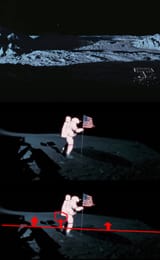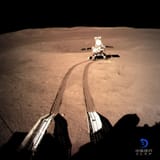CreepyThinMan
6/16/2025, 7:44:05 PM No.211544865
Happened upon this Joe Rogen podcast on the moon landing possibly being fake...
https://youtu.be/QIdAvFuwvuw?si=bgmX1wUp-Ns6VM2h
So here's my take with my evidence in picrel.
At 02:24 you can clearly see the line at the persons waist, just below the bottom of the backpack, where the ground ends and a painted backdrop begins while almost every shot has a flat horizon in the distance and none of the shadows extend beyond that line except at the far left where shadow goes slightly up and is more transparent than the bottom of the shadow and that's because it's hitting a flat wall.
This is an old technique that was often used in Star Trek where they'd have the landscape only extend to a painted backdrop on a wall and create a small ridge to hide the flat horizon that would be seen at the bottom of the wall.
They're even still doing this now but with the Digital Volume environments where the actors are on a small circular stage surrounded by a large monitor surrounding them that shows whatever environment they're supposed to be in and like Star Trek you can always tell where the bottom of the Volume begins because it'll be obscured with some substance running along to mask where it begins and the stage ends.
We also never see anyone pick up the camera and just point it around in every direction as it's always locked down while I looked up the Hasselblad cameras used and they're soo small a person could easily carry it in their hands not even taking into account the low gravity which would make it even lighter.
Then there's the Stanley Kubrick connection as 2001: A Space Odyssey came out a year before in 1968 where he recreated the surface of the moon which is lit in a cinematic style using a 960 Panavision 65mm handheld camera. In that case he was able to use multiple light sources so those camera could photograph the scene with no trouble.
https://youtu.be/QIdAvFuwvuw?si=bgmX1wUp-Ns6VM2h
So here's my take with my evidence in picrel.
At 02:24 you can clearly see the line at the persons waist, just below the bottom of the backpack, where the ground ends and a painted backdrop begins while almost every shot has a flat horizon in the distance and none of the shadows extend beyond that line except at the far left where shadow goes slightly up and is more transparent than the bottom of the shadow and that's because it's hitting a flat wall.
This is an old technique that was often used in Star Trek where they'd have the landscape only extend to a painted backdrop on a wall and create a small ridge to hide the flat horizon that would be seen at the bottom of the wall.
They're even still doing this now but with the Digital Volume environments where the actors are on a small circular stage surrounded by a large monitor surrounding them that shows whatever environment they're supposed to be in and like Star Trek you can always tell where the bottom of the Volume begins because it'll be obscured with some substance running along to mask where it begins and the stage ends.
We also never see anyone pick up the camera and just point it around in every direction as it's always locked down while I looked up the Hasselblad cameras used and they're soo small a person could easily carry it in their hands not even taking into account the low gravity which would make it even lighter.
Then there's the Stanley Kubrick connection as 2001: A Space Odyssey came out a year before in 1968 where he recreated the surface of the moon which is lit in a cinematic style using a 960 Panavision 65mm handheld camera. In that case he was able to use multiple light sources so those camera could photograph the scene with no trouble.
Replies:





